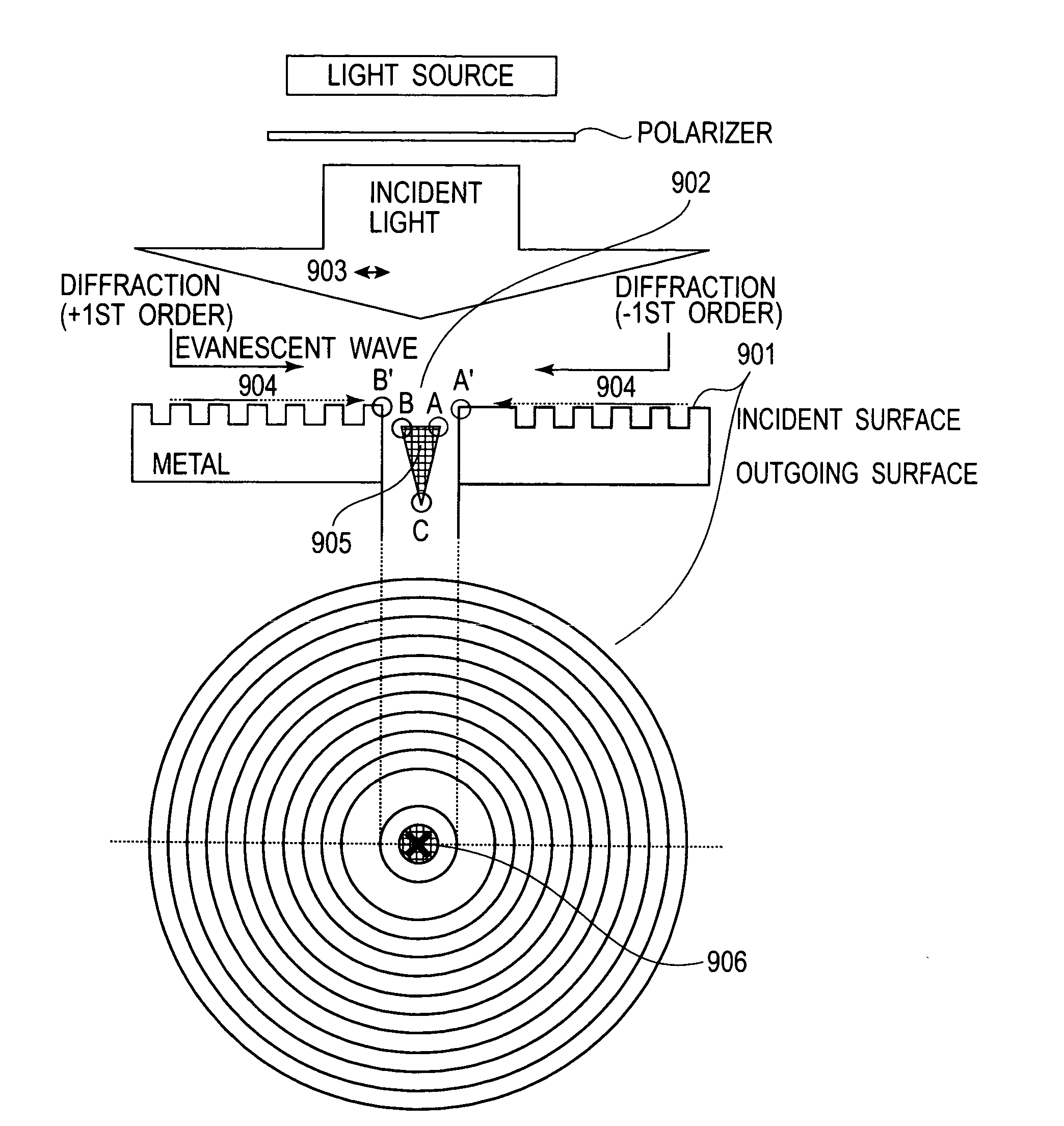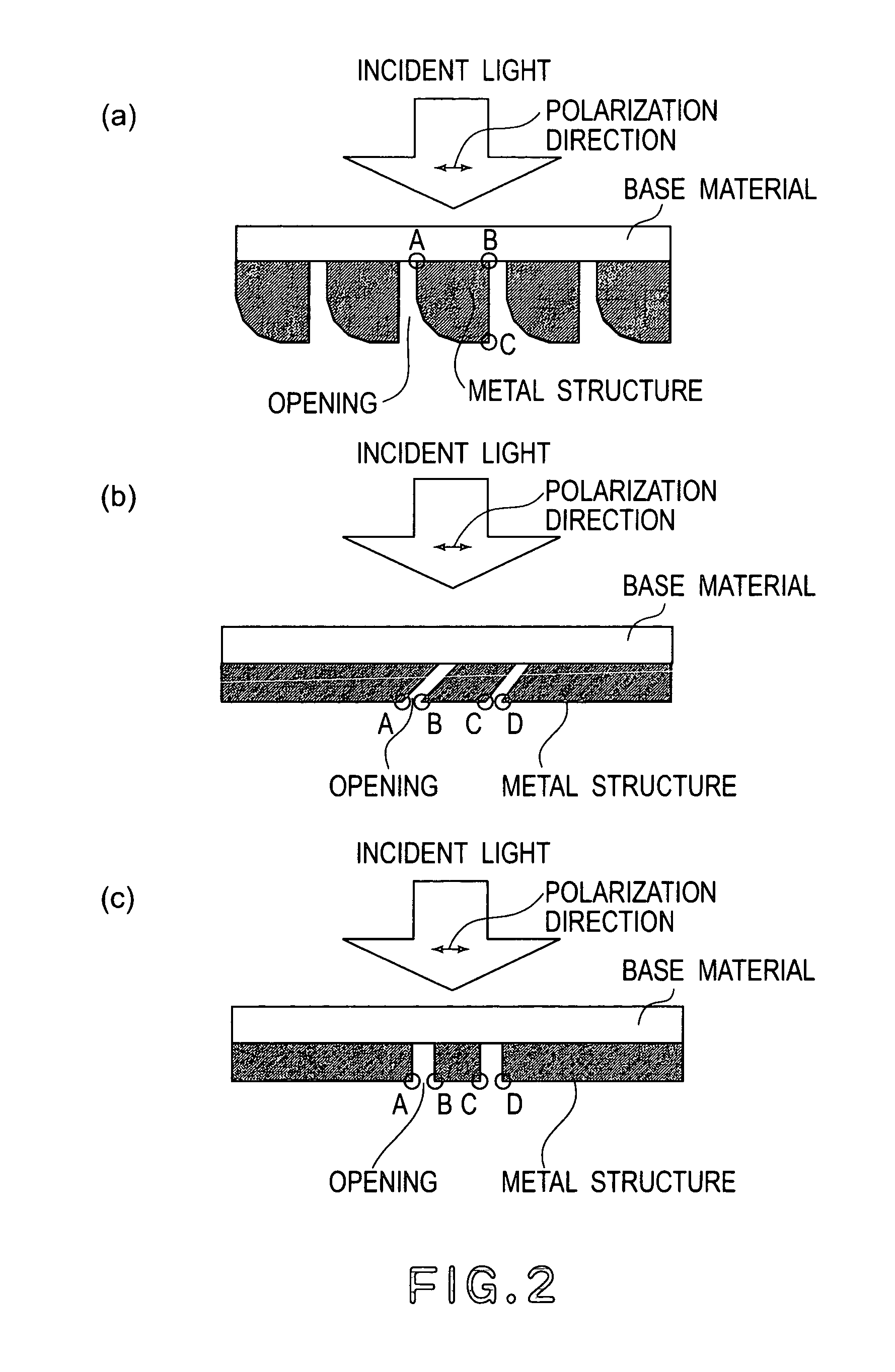Near-field light generating structure, near-field exposure mask, and near-field generating method
a near-field light and generating structure technology, applied in the field of near-field light generating structure, near-field exposure mask, near-field generating method, and near-field recording and reproducing an apparatus, can solve the problems of weak electric field generation, shortening the wavelength of laser light, and low throughput, so as to achieve efficient generation
- Summary
- Abstract
- Description
- Claims
- Application Information
AI Technical Summary
Benefits of technology
Problems solved by technology
Method used
Image
Examples
embodiment 1
FIGS. 3(a) to 3(f) are sectional views for illustrating production steps of a near-field exposure mask manufacturing method in this embodiment.
First of all, a substrate 301 of Si wafer with (100) plane is prepared. On each of both surfaces of the substrate 301, a 500 nm-thick silicon nitride layer is formed as a base material 302 (FIG. 3(a)).
Next, a back-etching opening 303 is formed is a pattern on the light-incident side surface of the base material 302 through lithography. On the light-outgoing side surface of the base material 302, a 50 nm-thick light blocking metal layer 304 of Cr is formed (FIG. 3(b)).
Then, on the light blocking metal layer 304, an etching mask layer (not shown) is formed and patterned in a slit array shape by using an EB drawing apparatus and a dry etching apparatus. Thereafter, a fine pattern 305 is formed in the light blocking metal layer 304 and the etching mask layer is removed (FIG. 3(c)). The patterning may also be performed through other methods...
embodiment 2
FIGS. 4(a) to 4(c) are sectional views for illustrating production steps of a near-field exposure mask manufacturing method in this embodiment.
First, a substrate 401 of Si wafer with (100) plane is prepared. On each of both surfaces of the substrate 401, a 500 nm-thick silicon nitride layer is formed as a base material 402 (FIG. 4(a)).
Next, a back-etching opening 403 is formed in a pattern on the light-incident side surface of the base material 402 through lithography. On the light-outgoing side surface of the base material 402, a 50 nm-thick light blocking metal layer 404 of Cr is formed (FIG. 4(b)).
Then, the light blocking metal layer 404 is subjected to patterning with focused ion beam 406. At that time, the light blocking metal layer 404 is formed in an asymmetrical shape by obliquely irradiating the substrate with the focused ion beam 406. Thereafter, in a KOH aqueous solution, anisotropic etching of the resultant structure is performed to prepare a near-field exposure m...
embodiment 3
FIGS. 6(a) to 6(d) are sectional views for illustrating production steps of a near-field exposure mask manufacturing method in this embodiment.
First, a substrate 601 of Si wafer with (100) plane is prepared. On each of both surfaces of the substrate 601, a 500 nm-thick silicon nitride layer is formed as a base material 602 (FIG. 6(a)).
Next, a back-etching opening 603 is formed in a pattern on the light-incident side surface of the base material 602 through lithography. On the light-outgoing side surface of the base material 602, a 50 nm-thick light blocking metal layer 604 of Cr is formed (FIG. 6(b)).
Onto the light blocking metal layer 604, a photoresist 605 is applied and subjected to patterning (FIG. 6(c)). During the patterning, the photoresist may preferably be exposed obliquely to light with respect to the substrate so as to provide an angle suitable for a subsequent step of performing oblique dry etching. Then, the dry etching is performed with respect to the substrate ...
PUM
 Login to View More
Login to View More Abstract
Description
Claims
Application Information
 Login to View More
Login to View More - R&D
- Intellectual Property
- Life Sciences
- Materials
- Tech Scout
- Unparalleled Data Quality
- Higher Quality Content
- 60% Fewer Hallucinations
Browse by: Latest US Patents, China's latest patents, Technical Efficacy Thesaurus, Application Domain, Technology Topic, Popular Technical Reports.
© 2025 PatSnap. All rights reserved.Legal|Privacy policy|Modern Slavery Act Transparency Statement|Sitemap|About US| Contact US: help@patsnap.com



